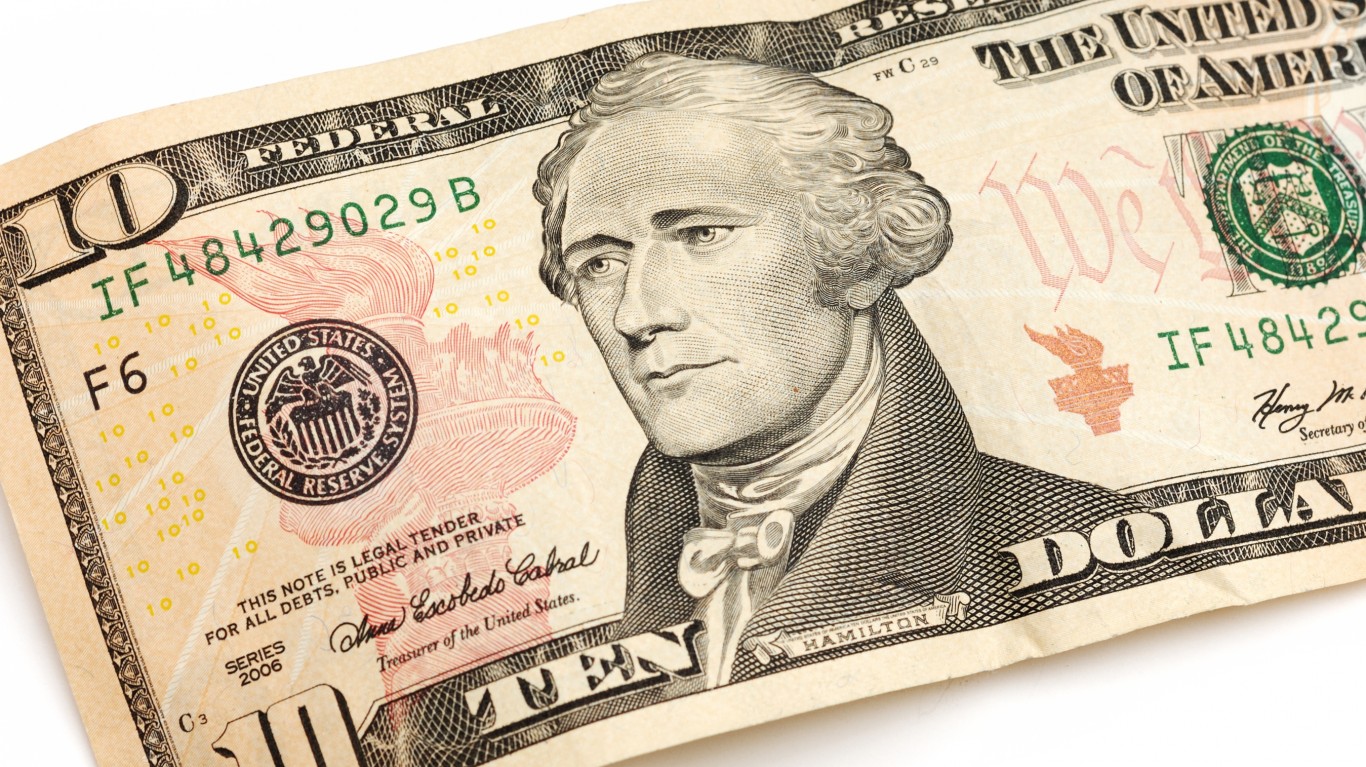 In the long history of poor management decisions made at major American companies, only a few proved to be fatal. It is hard to ruin a company with a single decision. That is especially true when the company has the advantages of huge market share, large and rising revenue, and a history of success. But not all bad decisions are created equal. 24/7 Wall St. set out to identify the worst business decisions of all time. These decisions cost these companies billions of dollars and, eventually, their independence.
In the long history of poor management decisions made at major American companies, only a few proved to be fatal. It is hard to ruin a company with a single decision. That is especially true when the company has the advantages of huge market share, large and rising revenue, and a history of success. But not all bad decisions are created equal. 24/7 Wall St. set out to identify the worst business decisions of all time. These decisions cost these companies billions of dollars and, eventually, their independence.
Read: The Worst Business Decisions of All Time
Bad business decisions result in financial loss. The worst business decisions lose companies billions in revenue. Our editors relied on Fortune magazine’s annual list of the largest 500 companies ranked by revenue to identify the companies that were the biggest in America and, as a result, capable of losing the most money.
To make the initial cut, companies had to be on the Fortune 100 list for at least 10 consecutive years and then drop off the top 100 ranking for good. We then looked for the companies that made a single identifiable decision that cost them significant revenue and ultimately led to their decline. Based on this cut, 24/7 Wall St. identified the eight companies that suffered from the worst business decisions of all time.
Inclusion at the top of the Fortune 500 is hard to get, but, once won, it is also hard to lose. Nearly three-quarters of 2012’s 100 largest companies have been in the top 100 for at least a decade. This includes 23 that have been there for a quarter century, as well as 13 companies that have been on the list since it debuted in 1955. Even if a company falls out of the top 100, it usually remains a large company for a long time. Seventy companies from the original Fortune 100 are still somewhere on the Fortune 500 list.
Most bad business decisions are not fatal. General Motors Co. (NYSE: GM) has made several mistakes, none as harmful as the decision to continue to manufacture large vehicles when the market was trending toward smaller cars. These poor judgment calls led to GM’s bankruptcy in 2009, but with the help of a government bailout it remains in the Fortune 100 today. This is not the case with the companies on this list. The decisions made at these companies eventually ruined each of them.
The worst bad decisions fall into three categories. The managements of Lehman Brothers and Firestone were simply reckless. Leading up to the housing collapse, Lehman executives overleveraged the investment bank, far more than any other large financial institution. Firestone hastily tried to expand into production of a new kind of tire. Both companies ignored internal warnings that their decisions were highly risky.
In the case of Kodak and Motorola, management missed tectonic shifts in their industries until it was too late. Motorola held on to its old cellphone business too long, failing to leverage its Razr brand or couple it with a smartphone until the brand had lost its relevance. Kodak, which actually held a patent for digital cameras well before they were mass produced, eventually was left behind by other digital camera manufacturers like Fuji and Sony Corp. (NYSE: SNE) that moved quickly to establish market dominance.
Kmart, meanwhile, showed a general lack of foresight. The retailer failed to create modern supply chain management that could support an increase in customers, something it should have expected following its price war with Wal-Mart Stores Inc. (NYSE: WMT) and aggressive advertising.
To identify the worst business decisions of all time, 24/7 Wall St. reviewed all Fortune 500 companies since 1955 that have, at any point, been in the top 100 for at least 10 years, but were no longer among them in 2012. A company needed to have either filed for bankruptcy protection or been acquired. The declines in the company’s fortunes also had to have been traced to one identifiable bad decision. For each of these companies, 24/7 Wall St. reviewed revenue and sales data, obtained from Capital IQ, as well as stock price performance.
1. Motorola
> Years on Fortune 500: 56
> Peak Fortune 500 rank: 23 (1994)
> Peak revenue: $43.7 billion (2006)
> Current status: Split, Mobility unit sold
The success of the thin and stylish Razr cellphone drove Motorola’s 22% market share in mobile phones in 2006. However, the company failed to launch a new generation of smartphones leveraging the Razr brand, and by 2007 the company was selling the traditional cellphone at a discount. By the time the company released a new line of Razr phones in 2010, Motorola had to compete with products such as the iPhone and BlackBerry. While sales in 2006 were more than $43 billion, they were only $22 billion by 2010. Between October 2006 and March 2009, the company’s shares fell more than 90% from over $107 to less than $13. Motorola Mobility, now owned by Google Inc. (NASDAQ: GOOG), had 11.2% market share of mobile phones in Aug. 2012, according to comScore. Apple Inc.’s (NASDAQ: AAPL) iPhone, released in 2007, had a 17.1% market share.
Also Read: Great American Companies That Will Survive the Fiscal Cliff
2. Lehman Bros.
> Years on Fortune 500: 14
> Peak Fortune 500 rank: 37 (2008)
> Peak revenue: $59.0 billion (2007)
> Status: Went bankrupt
During the final few years of the housing bubble, Lehman Brothers increased the amount it borrowed to buy more mortgage-backed securities and real estate. By 2007, the company’s leverage ratio was at least 31-to-1, meaning it borrowed $31 for every $1 in equity. This brought Lehman Brothers huge profits in the boom era but became a serious problem once the housing bubble burst. The firm was unable to unload those assets onto the market once home and commercial real estate prices began falling, leading to unsustainable losses. While other investment banks, including Goldman Sachs Group Inc. (NYSE: GS) and Morgan Stanley (NYSE: MS), were heavily leveraged as well, they were able to survive by becoming bank holding companies eligible to receive the necessary emergency funds from the government to continue operations. Those aid programs however, became available too late for Lehman, which went bankrupt in 2008. A federal-bankruptcy-court-sponsored report later found that Lehman and its accounting firm partner, Ernst & Young, used misleading accounting tactics to conceal the extent of Lehman’s overleveraging, which the authors claimed was as high as 44-to-1. Both Lehman executives and Ernst & Young denied these claims. Between 1999 and 2007 Lehman’s revenue grew from less than $19 billion to more than $59 billion. During that time, the company’s rank on the Fortune 500 rose from 88th to 37th.
3. Firestone
> Years on Fortune 500: 34
> Peak Fortune 500 rank: 24 (1956)
> Peak revenue: $5.3 billion (1979)
> Current status: Bought out
Firestone began manufacturing radial tires in 1972 to lengthen the life of the products. The company used a new technique to get its tires to market ahead of competitors. That year, after Firestone’s tire was in production, company documents reported that the rubber came off the wire when the tire was in use. Despite these problems, the company continued to manufacture the tires throughout the 1970s to satisfy demand from customers like General Motors. But following pressure from the government and consumer advocacy groups that were concerned about the safety of the tires, the company recalled approximately 10 million tires in 1978. Initially, Firestone blamed tire failure on substandard maintenance by the consumer. However, an investigation by the National Highway and Traffic Administration in 1980 found that Firestone was actually aware of the defective products, citing to the 1972 documents.This lead to lawsuits and negative publicity that hurt earnings and sales. Although the stock bounced back from its low of $6.25 in April 1980, shares were still below their 1969 peak of $33.25 when Bridgestone successfully bid for the company in 1988.
4. Digital Equipment Corp.
> Years on Fortune 500: 25
> Peak Fortune 500 rank: 27 (1990, 1993)
> Peak revenue: $14.6 billion (1996)
> Current status: Bought out
The fortunes of Digital Equipment Corp., maker of commercial electronics known as minicomputers, began to decline in the 1990s. DEC was successful because its products were priced below mainframes, which were made primarily by International Business Machines Corp. (NYSE: IBM). DEC controlled the minicomputer market from the mid-1960s until the early 1990s but failed to enter the workstation and personal computer markets quickly. When DEC finally decided to get into PCs, it tried to use its own operating platform, VMS, without success. Meanwhile, companies such as Hewlett-Packard Co. (NYSE: HPQ) and Sun Microsystems were able to gain market share in workstations by using UNIX operating system, which allowed for many more software applications than VMS. Meanwhile, computers from Hewlett-Packard and IBM, which were based on the Intel Corp. (NASDAQ: INTC) blueprint and Microsoft Corp. (NASDAQ: MSFT) OS, began to dominate the PC market in the late 1980s. Between 1991 and 1996, DEC lost money every year except for one, including more than $2 billion in 1992 and 1994. After joining the Fortune 500 in 1974, the company peaked in 1993 at 27th. In just six years, it fell to 118th place before Compaq bought it out in 1998.
5. Kmart
> Years on Fortune 500: 11
> Peak Fortune 500 rank: 15 (1995)
> Peak revenue: $37.0 billion (2000)
> Current status: Merged
Kmart’s big mistake in the mid-to-late 1990s was to try to compete with Walmart on price. Walmart had a supply chain system known as “just-in-time” inventory, which allowed the retailer to restock shelves efficiently. Kmart failed to implement a similar system, which meant consumers became frustrated when stores ran out of goods. Between June 1998 and June 2000, Walmart’s stock price rose 82% as Kmart’s fell 63%. While new management at the turn of the decade worked to improve efficiency, the company filed for bankruptcy in 2002 and shut hundreds of stores. Kmart merged with Sears Roebuck in 2005.
Also Read: 10 Brands Losing the Most Value
6. American Motors
> Years on Fortune 500: 33
> Peak Fortune 500 rank: 38 (1961)
> Peak revenue: $4.2 billion (1984)
> Current status: Bought out
By the time car manufacturer American Motors was absorbed by Chrysler in 1987, the company had been on a decline for more than 20 years. American first began to report losses in the mid 1960s. At the time, it failed in its efforts to compete with General Motors and Ford Motor Co. (NYSE: F) by expanding into large cars that could generate better profits per vehicle. Despite the losses, it was able to stay afloat through the next decade after it bought the Jeep brand in 1970 from Kaiser. But a weak economy hurt Jeep sales and began to restrict the company’s cash flow in the late 1970s. Additionally, overseas automakers began to pose a major threat. Japanese auto companies, which began to heavily market small cars in America, manufactured them in Japan where auto worker wages were much lower than in the United States. All American car companies, including American Motors, had long-standing labor agreements in place that dictated relatively higher salaries in the 1980s. American Motors lost money in all but one of the years between 1980 and 1986.
7. RCA
> Years on Fortune 500: 28
> Peak Fortune 500 rank: 15 (1968)
> Peak revenue: $8.0 billion (1980, 1981)
> Current status: Bought out
Consumer electronics manufacturer RCA was highly regarded through most of its history as particularly innovative — the company was the first to sell electronic televisions to a wide market. Yet, from the mid 1960s and into the 1970s, the company began to diversify beyond the scope of its traditional business. Its expansion was so rapid and so far flung that the company has become unmanageable. It bought a motley collection of companies, including publisher Random House in 1965, car rental company Hertz in 1967 and frozen food maker Banquet in 1970. The company even tried to make a push into IBM’s territory with mainframe computers. While it diversified, the company scaled back research and development spending on its core product lines. When these acquisitions proved unsuccessful, RCA announced that it would return to focus on its traditional products, which mostly consisted of color televisions. By then, however, the company had to compete with Asian manufacturers that made cheaper consumer electronics goods. The company was eventually sold to General Electric Co. (NYSE: GE) in 1986.
8. Kodak
> Years on Fortune 500: 58
> Peak Fortune 500 rank: 18 (1989, 1990, 1992)
> Peak revenue: $20.6 billion (1992)
> Status: In bankruptcy
Eastman Kodak developed the digital camera in 1975 but did not invest in the technology for fear it would undercut sales of its film business — Kodak’s executives did not foresee the eventual decline of film. Only when film’s popularity began to wane in the mid-1990s in favor of digital photography did the company push into the digital market. But competitors such as Fuji and Sony entered the market faster and Kodak was never able to fully capitalize on the product it actually invented. By 2001, the company was in second-place to Sony in the digital camera market, but it lost $60 on every camera sold. By 2010, it ranked sixth in the digital camera space, which itself began to dwindle with the advent of smartphones and tablets. Eastman Kodak shares peaked in 1997 at more than $94 per share, proof that it often takes a number of years for poor decisions to destroy huge corporations. By 2011, the stock had dropped to 65 cents per share, and the company filed for bankruptcy in December of that year. Kodak, always one the Fortune 500 companies, might not even make the 2013 list.
Douglas A. McIntyre, Ashley C. Allen, Samuel Weigley and Michael B. Sauter
Also Read: America’s Richest Cities
Smart Investors Are Quietly Loading Up on These “Dividend Legends” (Sponsored)
If you want your portfolio to pay you cash like clockwork, it’s time to stop blindly following conventional wisdom like relying on Dividend Aristocrats. There’s a better option, and we want to show you. We’re offering a brand-new report on 2 stocks we believe offer the rare combination of a high dividend yield and significant stock appreciation upside. If you’re tired of feeling one step behind in this market, this free report is a must-read for you.
Click here to download your FREE copy of “2 Dividend Legends to Hold Forever” and start improving your portfolio today.
Thank you for reading! Have some feedback for us?
Contact the 24/7 Wall St. editorial team.



